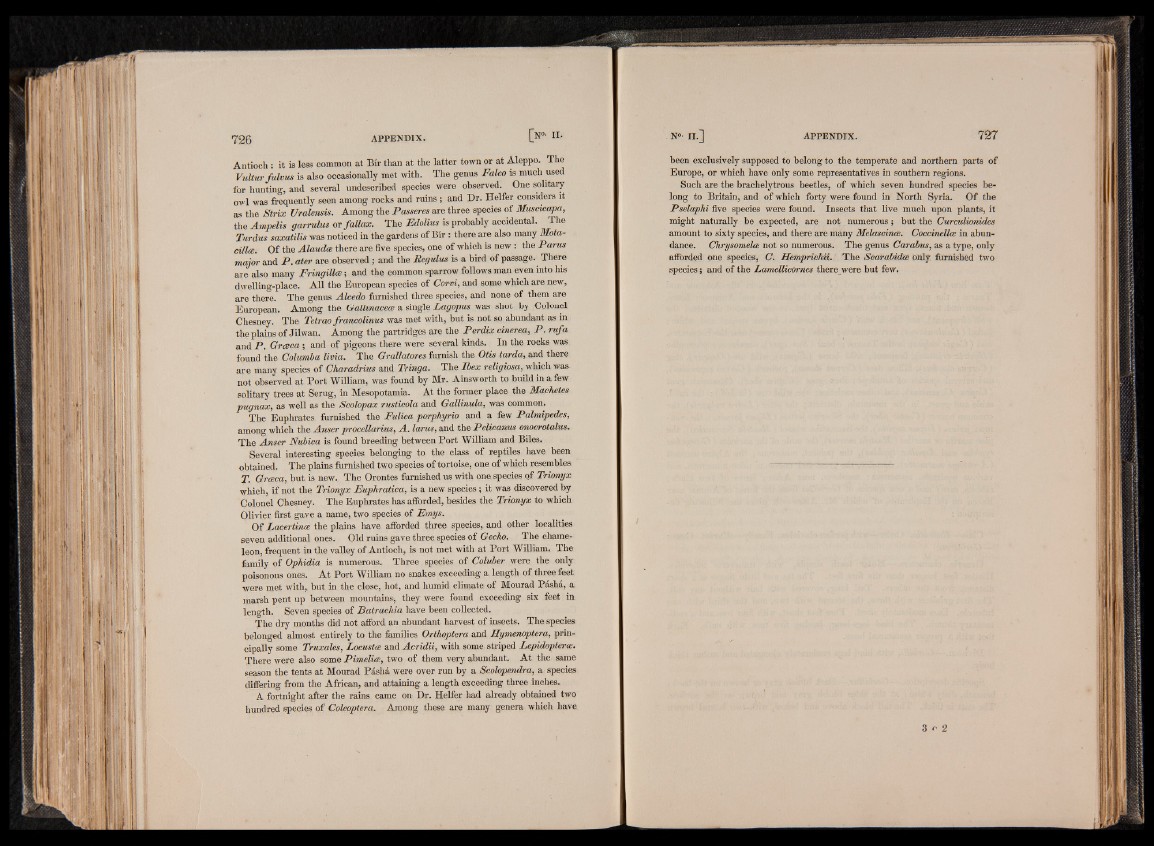
Antioch : it is less common at Bir than at the latter town or at Aleppo. The
Vultur fulvus is also occasionally met with. The genus Falco is much used
for hunting, and several undescribed species were observed. One solitary
owl was frequently seen among rocks and ruins ; and Dr. Heifer considers it
as the S trix Uralensis. Among the Passeres are three species of Muscícapa,
the Ampelis garrulus or fa lla x . The Edolius is probably accidental. The
Tardus saxatilis was noticed in the gardens of Blr : there are also many Mota-
cillce. Of the Alaudce there are five species, one of which is new : the Parus
major and P . ater are observed ; and the Regulus is a bird of passage. There
are also many Fringillce; and the common sparrow follows man even into his
dwelling-place. A ll the European species of Corvi, and some which are new,
are there. The genus Alcedo furnished three species, and none of them are
European. Among the Gallinácea a single Lagopus was shot by Colonel
Chesney. The Tetrao francolinas was met with, but is not so abundant as in
the plains of Jilwan. Among the partridges are the Perdix cinerea, P . rufa
and P . Grceca; and of pigeons there were several kinds. In the rocks was
found the Columba livia. The Grallatores furnish the Otis tarda, and there
a re many species of Charadrius and Tringa. The Ibex religiosa, which was
not observed at Po rt William, was found by Mr. Ainsworth to build in a few
solitary trees at Serug, in Mesopotamia. At the former place the Machetes
pugnax, as well as the Scolopax rusticóla and Gallínula, was common.
The Euphrates furnished the Fúlica porphyrio and a few Palmipedes,
among which the Anser procellarius, A . larus, and the Pelicanas onocrotalus.
The Anser Nubica is found breeding between Port William and Biles.
Several interesting species belonging to the class of reptiles have been
obtained. The plains furnished two species of tortoise, one of which resembles,
T. Grceca, but is new. The Orontes furnished us with one species of Trionyx
which, if not the Trionyx Euphratica, is a new species; it was discovered by
Colonel Chesney. The Euphrates has afforded, besides the Trionyx to which
Olivier first gave a name, two species of Emys.
Of Lacertince the plains have afforded three species, and other localities
seven additional ones. Old ruins gave three species o f Gecko. The chameleon,
frequent in the valley of Antioch, is not met with at Port William. The
family of Ophidia is numerous. Three species of Coluber were the only
poisonous ones. A t Port William no snakes exceeding a length of three feet
were met with, but in the close, hot, and humid climate of Mourad Páshá, a
marsh pent up between mountains, they were found exceeding six feet in
length. Seven species of Batrachia have been collected.
The dry months did not afford an abundant harvest of insects. The species
belonged almost entirely to the families Orthoptera and Hymenoptera, principally
some Truxales, Locusta and Acridii, with some striped Lepidopterce.
There were also some Pimelice, two of them very abundant. At the same
season the tents at Mourad Páshá were over run by a Scolopendra, a species
differing from the African, and attaining a length exceeding three inches.
A fortnight after the rains came on Dr. Heifer had already obtained two
hundred species of Coleóptera. Among these are many genera which have
been exclusively supposed to belong to the temperate and northern parts of
Europe, or which have only some representatives in southern regions.
Such are the brachelytrous beetles, of which seven hundred species belong
to Britain, and of which forty were found in North Syria. Of the
Pselaphi five species were found. Insects that live much upon plants, it
might naturally be expected, are not numerous; but the Curculionides
amount to sixty species, and there are many Melascince. Coccinellce in abundance.
Chrysomelce not so numerous. The genus Carabus, as a type, only
afforded one species, C. Hemprichii. The Scarabidie only furnished two
species; and of the Lamellicornes there were but few.